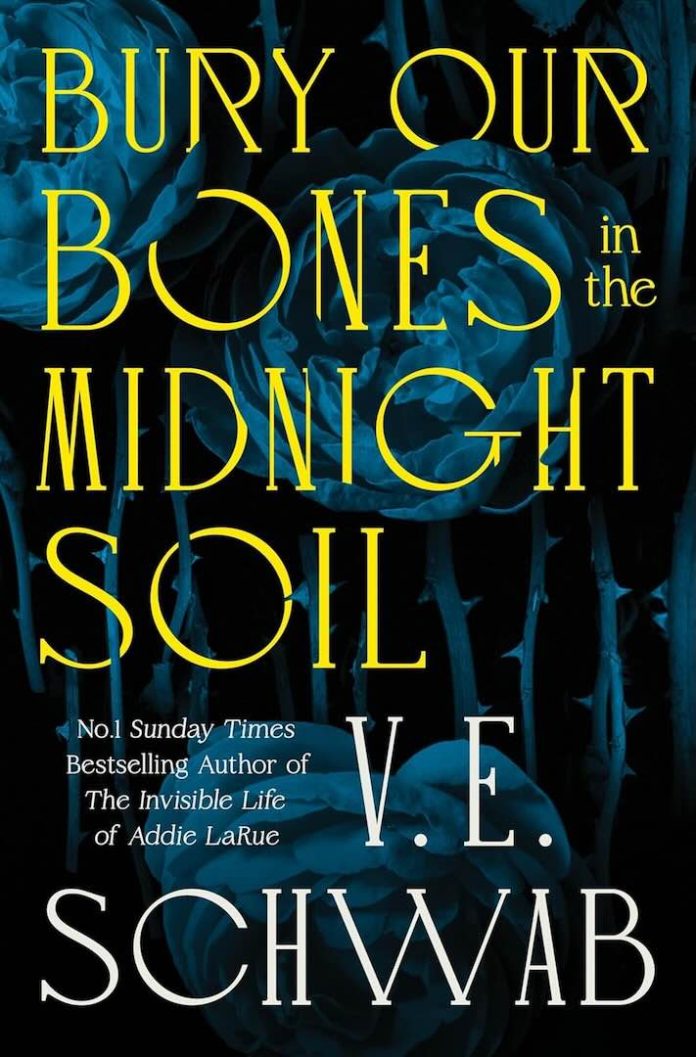V.E. Schwab returns with her most ambitious and haunting work yet—a genre-defying novel that weaves together centuries of longing, loss, and the complex nature of immortal hunger. Bury Our Bones in the Midnight Soil is a masterful exploration of what it means to be human when humanity itself becomes a choice rather than a birthright.
A Story Told Through Time’s Shadows
The narrative unfolds across three timelines, each anchored by a woman whose life becomes forever entangled with the immortal predator known as Sabine. Beginning in 1532 Santo Domingo de la Calzada with María, a young Spanish girl desperate to escape the constraints of her predetermined life, the story travels to 1827 London where Charlotte, a sheltered English woman, discovers forbidden love, and finally arrives in 2019 Boston where Alice, a college student, stumbles into a world far darker than she imagined.
Schwab’s structural choices here are particularly brilliant. Rather than following a linear progression, the novel moves like memory itself—fluid, fragmented, and deeply emotional. Each timeline informs the others, creating a rich tapestry where past actions echo through centuries. The author demonstrates her mastery of voice by giving each era its own distinct narrative rhythm while maintaining the gothic atmosphere that permeates the entire work.
The Evolution of Horror Through the Ages
What sets this novel apart from other vampire fiction is Schwab’s refusal to romanticize the monstrous. María’s transformation from victim to predator is portrayed with unflinching honesty—there’s no moment of beautiful awakening, no gentle introduction to supernatural powers. Instead, we witness the brutal reality of what it means to survive when survival requires consuming others.
Charlotte’s story, perhaps the most tragic of the three, explores the psychological toll of loving someone whose very nature is predatory. Schwab doesn’t shy away from depicting the complexities of an abusive relationship, even when that abuse is wrapped in supernatural beauty and centuries of shared experience. The gradual erosion of Charlotte’s agency, her willingness to excuse increasingly violent behavior, reads as both gothic horror and contemporary social commentary.
Alice’s modern timeline brings these ancient horrors into our digital age, where smartphones capture evidence and social media creates its own form of surveillance. Yet the fundamental questions remain unchanged: what does it mean to hunger, to need, to survive at the expense of others?
Character Development and Psychological Depth
Sabine: The Beautiful Monster
Originally María, Sabine emerges as one of the most complex antagonists in recent fantasy literature. Schwab avoids the trap of making her vampire either wholly sympathetic or completely evil. Instead, she presents a character shaped by centuries of violence who has lost the ability to form genuine connections. Her relationship with each woman—María’s desperation, Charlotte’s devotion, Alice’s defiance—reveals different facets of her nature while showing how immortality can poison even the capacity for love.
The author’s decision to show us María before she becomes Sabine is particularly effective. We understand the circumstances that led to her transformation while never excusing the monster she becomes. This nuanced portrayal elevates the novel beyond simple horror into something approaching tragedy.
The Women Who Resist
Each of the three protagonists represents a different response to trauma and supernatural threat. María chooses transformation as escape, Charlotte chooses love despite its destructive nature, and Alice chooses to fight back. These aren’t simply victims in a horror story—they’re fully realized characters with their own agency, desires, and fatal flaws.
Alice’s character arc proves especially compelling. Her transformation from insecure college student to something more dangerous mirrors the novel’s exploration of what we’re willing to sacrifice for survival. The revelation about her mother’s grave dirt—worn as a pendant and serving as both protection and weakness—demonstrates Schwab’s skill at weaving mythology into character development.
Literary Craftsmanship and Style
Schwab’s prose throughout the novel is nothing short of exquisite. She adapts her writing style to match each time period while maintaining her distinctive voice. The Spanish sections pulse with heat and desperate energy, the Victorian sequences unfold with careful formality hiding violent passion, and the contemporary timeline moves with the quick, fragmented pace of modern life.
Atmospheric World-Building
The author excels at creating a sense of place that feels both historically accurate and mythologically rich. Santo Domingo de la Calzada breathes with the dust and desperation of 16th-century Spain, while Victorian London becomes a maze of shadows where predators can hide in plain sight. Modern Boston, with its college campuses and underground clubs, provides the perfect backdrop for ancient evils adapting to contemporary life.
The recurring imagery of roses—beautiful but thorned, cultivated but wild—runs throughout the novel as both metaphor and literal element. Gardens become spaces of both growth and decay, reflecting the dual nature of the characters who tend them.
Themes and Social Commentary
The Nature of Hunger
The novel’s central metaphor of hunger operates on multiple levels. There’s the literal hunger of vampires for blood, but also the hunger for love, freedom, acceptance, and meaning. Each character struggles with desires that seem impossible to satisfy, creating parallels between supernatural and human need.
Schwab uses this metaphor to explore contemporary issues around consent, power dynamics, and survival. The immortals in this world don’t simply feed—they consume entire lives, memories, experiences. This becomes a powerful metaphor for how trauma can devour not just individuals but entire generations.
Gender, Power, and Agency
Throughout the novel, Schwab examines how women navigate systems designed to limit their choices. María’s transformation comes from her refusal to accept a predetermined fate as “prize or pawn.” Charlotte’s story explores how love can become another form of cage. Alice’s journey represents a more modern approach to claiming agency, even when that agency comes at a terrible cost.
Critiques and Minor Flaws
While Bury Our Bones in the Midnight Soil succeeds brilliantly as both horror and literary fiction, it occasionally suffers from pacing issues. The multiple timelines, while thematically powerful, sometimes fragment the narrative tension. Certain transitions between time periods feel abrupt, potentially leaving readers momentarily disoriented.
Additionally, some of the contemporary dialogue in Alice’s sections occasionally feels forced, as if Schwab is trying too hard to capture modern speech patterns. These moments are rare but noticeable enough to briefly pull readers out of the carefully constructed atmosphere.
The novel’s length might also challenge some readers. At over 400 pages, it requires commitment, and the complex timeline structure demands attention. However, for readers willing to invest in the journey, the payoff proves substantial.
Context Within Schwab’s Body of Work
Fans of Schwab’s previous works—from the Shades of Magic series to The Invisible Life of Addie LaRue—will recognize her fascination with characters caught between worlds, the price of power, and the weight of time. Bury Our Bones in the Midnight Soil represents perhaps her darkest exploration of these themes yet, while maintaining the emotional depth and complex character relationships that have made her a bestselling author.
Bury Our Bones in the Midnight Soil shares DNA with Addie LaRue in its exploration of immortality’s costs, but where Addie’s curse was designed to erase her, Sabine’s transformation amplifies her worst qualities. This creates a fascinating contrast between two very different approaches to supernatural consequence.
Genre Classification and Market Position
Bury Our Bones in the Midnight Soil defies easy categorization, blending elements of:
- Gothic Horror – Traditional vampire mythology updated for contemporary readers
- Historical Fiction – Carefully researched period details across three eras
- Literary Fantasy – Complex character studies wrapped in supernatural elements
- LGBTQ+ Fiction – Meaningful representation woven naturally into the narrative
- Psychological Thriller – Examination of trauma, abuse, and survival
Similar Reading Recommendations
Readers who appreciate Bury Our Bones in the Midnight Soil might enjoy:
- The Seven Husbands of Evelyn Hugo by Taylor Jenkins Reid (for complex female characters across multiple timelines)
- Mexican Gothic by Silvia Moreno-Garcia (for atmospheric horror with historical elements)
- The Ten Thousand Doors of January by Alix E. Harrow (for lyrical fantasy exploring agency and belonging)
- The Priory of the Orange Tree by Samantha Shannon (for epic fantasy with LGBTQ+ representation)
- The Death of Jane Lawrence by Caitlin Starling (for gothic horror examining power and trauma)
- Interview with the Vampire by Anne Rice (for classic vampire literature with psychological depth)
Final Verdict
Bury Our Bones in the Midnight Soil stands as V.E. Schwab’s most mature and ambitious work to date. It successfully combines the accessibility of popular fantasy with the depth and complexity of literary fiction. While it may challenge readers with its structure and dark themes, those who embrace its complexities will find themselves rewarded with a rich, emotionally resonant story that lingers long after the final page.
The novel’s exploration of hunger—both literal and metaphorical—feels particularly relevant in our current cultural moment, where questions of consent, power, and survival dominate public discourse. Schwab has created something both timeless and timely, a gothic masterpiece that speaks to contemporary concerns while honoring the traditions of its genre.
For readers seeking fantasy that challenges as much as it entertains, Bury Our Bones in the Midnight Soil delivers in spades. It confirms Schwab’s position as one of the most important voices in contemporary speculative fiction, capable of crafting stories that are simultaneously beautiful and terrible, hopeful and haunting.





